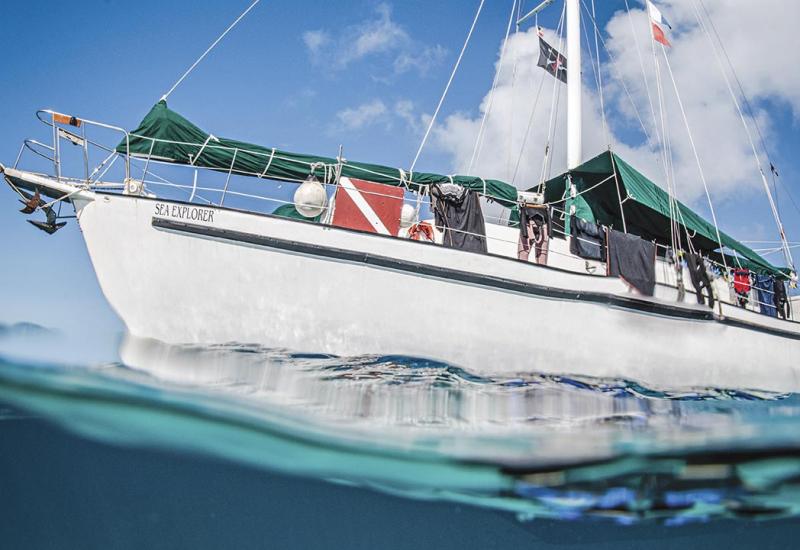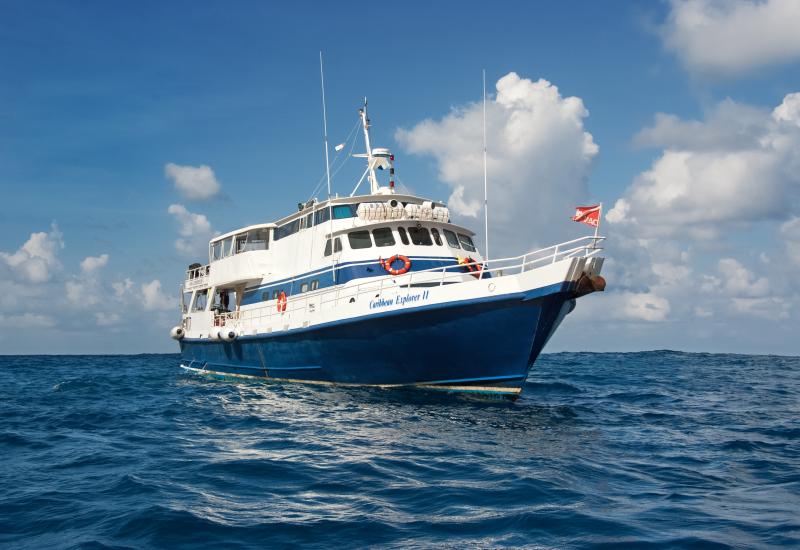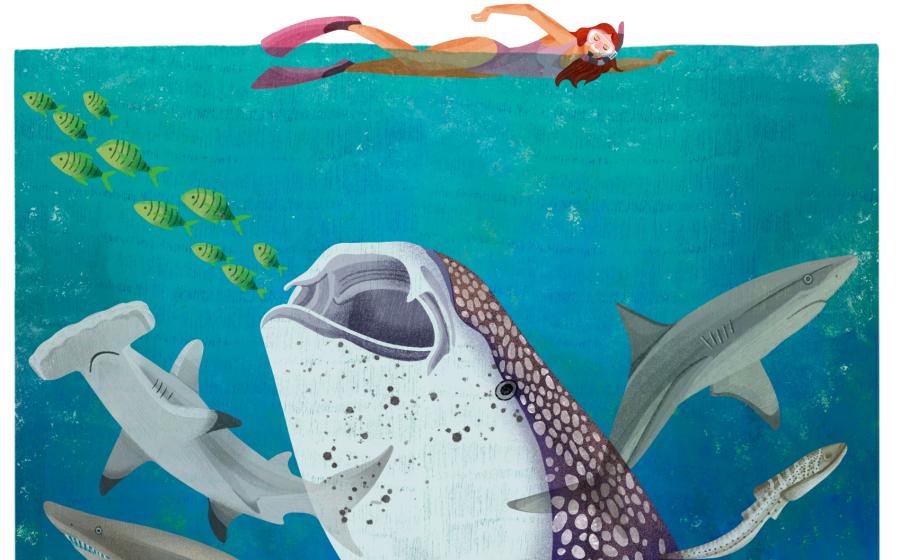Sea lions and Sharks in the Galapagos
Earlier wake-up call than usual today, for a pre-breakfast dive on Roca Redonda, a small rock north of Isabela. While diving has been a bit challenging at times — swift currents, strong surge — nothing compares to Redonda, apparently, so the dive briefing was more than a bit heavy on warnings of up and down currents, powerful surge, and cold water.
The reality was far less ominous. The surge was strong enough, and visibility was about half what we’ve enjoyed so far on this trip, but the current was negligible for most of the dive and the water was in the mid 70s F.
The dive was excellent, best shark dive of the trip so far. We started out though at the fumaroles, a sandy patch at 50 feet with hundreds of vents that emitted tiny streams of bubbles. In all honesty, spent too much time there, because while it’s a cool geographic feature there ended up being much better action further on.
Despite the poor vis (or maybe because we were forced to focus closer), we got great close-up action of hammerheads, which would come in small groups; Galapagos sharks and silky sharks too. There was a mobula ray midway through the dive, and a sea lion that darted in and out, but never stayed put enough for a photo.
We pulled up and headed south toward Isabela, stopping momentarily to celebrate crossing the equator. (Sadly, they wouldn’t let us off the boat to swim across the equator.) We arrived to a more crowded bay, with a few “eco boats” already anchored, taking people snorkeling along the shore or in close for photos of the wildlife.
Our second dive of the day was the polar opposite to every dive we’d made so far. For starters, it was cold. Some computers registered 58 degrees, but most were around 62-66 degrees F. That’s chilly, even for those of us with multiple layers. (I had on a Camaro Alpha 5mm on top of a 2mm titanium jumpsuit, thick 5mm gloves, and a titanium 0.5mm hood under a 3mm hood, and I was a little chilled.)
As soon as we settled on the sea floor at 20 feet, the divemaster signaled a mola mola, which swam near Gavin and then straight at me and away. We then had fabulous encounters with a family of sea lions, including one playful youngster that followed us for the entire dive. I got great video of a family of three; a pair play-acting in front of Humi; and later in the dive, the same youngster torturing a poor pufferfish, swimming around and around the puffer, nudging it with its nose until the sea lion finally let it swim away. We were also treated to the famous red-lipped batfish, the endemic salema, and a few horn sharks.
The second dive was the most disappointing of the trip. The sun was partly behind the headland, leaving the wall in perpetual shadow. With the green water, visibility was down to around 15 feet. Managed to get in close and see 10-12 red-lipped batfish on the sand, 8-10 horn sharks either swimming about or hidden under ledges, and a mola mola at the safety stop. But the 45-minute mark couldn’t come fast enough, as we were all chilled to the bone.
But the best was yet to come. For 1.5 hours in the late afternoon/early evening, we sat in a tender and explored about 400 yards of shoreline. In order, we saw: marine iguanas, Galapagos penguins, blue-footed boobies, a mobula ray inside the large cave on the headland, sea lions, more penguins, and finally the flightless cormorants — one of which got in the water to come and visit our boat. I dunked my GoPro in and got video of it swimming up and then pecking at the lens on the housing. This experience was almost as good as the diving, and just goes to show how impressive a trip here is with all the land and marine life to see.
Earlier wake-up call than usual today, for a pre-breakfast dive on Roca Redonda, a small rock north of Isabela. While diving has been a bit challenging at times — swift currents, strong surge — nothing compares to Redonda, apparently, so the dive briefing was more than a bit heavy on warnings of up and down currents, powerful surge, and cold water.
The reality was far less ominous. The surge was strong enough, and visibility was about half what we’ve enjoyed so far on this trip, but the current was negligible for most of the dive and the water was in the mid 70s F.
The dive was excellent, best shark dive of the trip so far. We started out though at the fumaroles, a sandy patch at 50 feet with hundreds of vents that emitted tiny streams of bubbles. In all honesty, spent too much time there, because while it’s a cool geographic feature there ended up being much better action further on.
Despite the poor vis (or maybe because we were forced to focus closer), we got great close-up action of hammerheads, which would come in small groups; Galapagos sharks and silky sharks too. There was a mobula ray midway through the dive, and a sea lion that darted in and out, but never stayed put enough for a photo.
We pulled up and headed south toward Isabela, stopping momentarily to celebrate crossing the equator. (Sadly, they wouldn’t let us off the boat to swim across the equator.) We arrived to a more crowded bay, with a few “eco boats” already anchored, taking people snorkeling along the shore or in close for photos of the wildlife.
Our second dive of the day was the polar opposite to every dive we’d made so far. For starters, it was cold. Some computers registered 58 degrees, but most were around 62-66 degrees F. That’s chilly, even for those of us with multiple layers. (I had on a Camaro Alpha 5mm on top of a 2mm titanium jumpsuit, thick 5mm gloves, and a titanium 0.5mm hood under a 3mm hood, and I was a little chilled.)
As soon as we settled on the sea floor at 20 feet, the divemaster signaled a mola mola, which swam near Gavin and then straight at me and away. We then had fabulous encounters with a family of sea lions, including one playful youngster that followed us for the entire dive. I got great video of a family of three; a pair play-acting in front of Humi; and later in the dive, the same youngster torturing a poor pufferfish, swimming around and around the puffer, nudging it with its nose until the sea lion finally let it swim away. We were also treated to the famous red-lipped batfish, the endemic salema, and a few horn sharks.
The second dive was the most disappointing of the trip. The sun was partly behind the headland, leaving the wall in perpetual shadow. With the green water, visibility was down to around 15 feet. Managed to get in close and see 10-12 red-lipped batfish on the sand, 8-10 horn sharks either swimming about or hidden under ledges, and a mola mola at the safety stop. But the 45-minute mark couldn’t come fast enough, as we were all chilled to the bone.
But the best was yet to come. For 1.5 hours in the late afternoon/early evening, we sat in a tender and explored about 400 yards of shoreline. In order, we saw: marine iguanas, Galapagos penguins, blue-footed boobies, a mobula ray inside the large cave on the headland, sea lions, more penguins, and finally the flightless cormorants — one of which got in the water to come and visit our boat. I dunked my GoPro in and got video of it swimming up and then pecking at the lens on the housing. This experience was almost as good as the diving, and just goes to show how impressive a trip here is with all the land and marine life to see.










